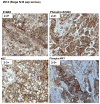High incidence of ErbB3, ErbB4, and MET expression in ovarian cancer
- PMID: 24901400
- PMCID: PMC4153698
- DOI: 10.1097/PGP.0000000000000081
High incidence of ErbB3, ErbB4, and MET expression in ovarian cancer
Abstract
Ovarian cancer is the leading cause of death from gynecologic cancers in the United States. Failure may be due to variable expression and/or complex interactions of growth factor receptors in individual tumors. As ErbB3-MET cooperativity is implicated in solid tumor resistance to EGFR/ErbB2 inhibitors, we evaluated expression of MET and all 4 ErbB family members in ovarian cancers. Tissue arrays were prepared from archival formalin-fixed paraffin-embedded tumor samples, including 202 ovarian carcinomas (Stage I-IV) and controls. Of 202 patient samples, only 25% were positive for EGFR and 35% for ErbB2 expression. ErbB3, ErbB4, and MET showed marked expression in 76%, 98%, and 96% of cases. Consistent with high incidence, there was no significant correlation for expression of ErbB3, ErbB4, or MET with outcome. On the basis of their high expression in the majority of cases, inhibitors targeting ErbB3, ErbB4, and/or MET may be broadly applicable as therapeutic agents in this disease.
Conflict of interest statement
Figures



Similar articles
-
[Relationship of expression of C-erbB2, C-erbB3, and C-erbB4 with ovarian carcinoma].Ai Zheng. 2004 May;23(5):568-72. Ai Zheng. 2004. PMID: 15142456 Chinese.
-
ErbB2, ErbB3 and ErbB4 expression in urothelial tumors of the upper urinary tract and their prognostic significance.J BUON. 2013 Jul-Sep;18(3):653-9. J BUON. 2013. PMID: 24065479
-
Prognostic value of ERBB family mRNA expression in breast carcinomas.Int J Cancer. 2003 Sep 20;106(5):758-65. doi: 10.1002/ijc.11273. Int J Cancer. 2003. PMID: 12866037
-
Targeting of erbB3 receptor to overcome resistance in cancer treatment.Mol Cancer. 2014 May 8;13:105. doi: 10.1186/1476-4598-13-105. Mol Cancer. 2014. PMID: 24886126 Free PMC article. Review.
-
The therapeutic potential of targeting the EGFR family in epithelial ovarian cancer.Br J Cancer. 2011 Apr 12;104(8):1241-5. doi: 10.1038/bjc.2011.62. Epub 2011 Mar 1. Br J Cancer. 2011. PMID: 21364581 Free PMC article. Review.
Cited by
-
Ovarian Tumor Microenvironment Signaling: Convergence on the Rac1 GTPase.Cancers (Basel). 2018 Sep 27;10(10):358. doi: 10.3390/cancers10100358. Cancers (Basel). 2018. PMID: 30261690 Free PMC article. Review.
-
Co-expression and prognostic significance of the HER family members, EGFRvIII, c-MET, CD44 in patients with ovarian cancer.Oncotarget. 2018 Apr 13;9(28):19662-19674. doi: 10.18632/oncotarget.24791. eCollection 2018 Apr 13. Oncotarget. 2018. PMID: 29731973 Free PMC article.
-
A Combination of Two Receptor Tyrosine Kinase Inhibitors, Canertinib and PHA665752 Compromises Ovarian Cancer Cell Growth in 3D Cell Models.Oncol Ther. 2016;4(2):257-274. doi: 10.1007/s40487-016-0031-1. Epub 2016 Sep 27. Oncol Ther. 2016. PMID: 28261654 Free PMC article.
-
Anti‑HER3 monoclonal antibody exerts antitumor activity in a mouse model of colorectal adenocarcinoma.Oncol Rep. 2021 Aug;46(2):173. doi: 10.3892/or.2021.8124. Epub 2021 Jun 29. Oncol Rep. 2021. PMID: 34184091 Free PMC article.
-
Epigenetic Dysregulation at the Crossroad of Women's Cancer.Cancers (Basel). 2019 Aug 16;11(8):1193. doi: 10.3390/cancers11081193. Cancers (Basel). 2019. PMID: 31426393 Free PMC article. Review.
References
-
- Siegel R, Naishadham D, Jemal A. Cancer statistics, 2012. CA Cancer J Clin. 2012;62:10–29. - PubMed
-
- Piccart MJ, Bertelsen K, Stuart G, et al. Long-term follow-up confirms a survival advantage of the paclitaxel-cisplatin regimen over the cyclophosphamide-cisplatin combination in advanced ovarian cancer. Int J Gynecol Cancer. 2003;13 (Suppl 2):144–8. - PubMed
-
- Burger RA, Brady MF, Bookman MA, et al. Incorporation of bevacizumab in the primary treatment of ovarian cancer. The New England journal of medicine. 2011;365:2473–83. - PubMed
-
- Perren TJ, Swart AM, Pfisterer J, et al. A phase 3 trial of bevacizumab in ovarian cancer. The New England journal of medicine. 2011;365:2484–96. - PubMed
Publication types
MeSH terms
Substances
Grants and funding
LinkOut - more resources
Full Text Sources
Other Literature Sources
Medical
Research Materials
Miscellaneous

